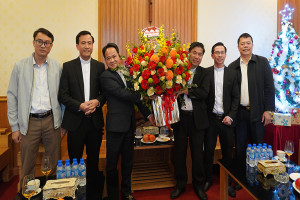
A conference has been held on the occasion of the 311th death anniversary of Zen Master Thuy Nguyet and nearly 350 years of Caodong Zen’s presence in Vietnam.
The Institute for Religious Studies (Vietnam Academy of Social Sciences), the Central Cultural Committee (Vietnam Buddhist Sangha), the Hai Duong provincial Buddhist Sangha, the provincial Department of Culture, Sports, and Tourism, Vietnam Caodong Sect, and the Kinh Mon District People’s Committee on December 14 held a scientific conference themed “Vietnam Caodong Zen and Nham Duong relic complex: Historical, cultural, and Buddhist value” on the occasion of the 311th death anniversary of Zen Master Thuy Nguyet and nearly 350 years of Caodong Zen’s presence in Vietnam.
43 presentations at the conference affirmed that Caodong Zen entered Vietnam in around the 2nd half of the 17th century.
Nham Duong pagoda is a place associated with Dao Nam Thong Giac Thuy Nguyet, the patriarch of Vietnam Caodong Zen. The pagoda, built in the Tran dynasty (1225 – 1400), is surrounded by about 30 small and large caves.
In Thanh Hoa cave where Patriarch Thuy Nguyet passed away, archaeologists have found many fossil remains, relics from the Stone and Brass Ages, and Buddha statues dating back to the Nguyen dynasty.
Nham Duong relic area was classified as a national one in 2003.
The conference upheld historical, cultural, archeological, and Buddhist value and, at the same time, expressed deep feelings and gratitude to famous Vietnamese monks in the 17th century, including Zen Master Thuy Nguyet, for their great contributions to the religion and nation.
This was also an occasion for researchers in and outside Vietnam Buddhism to scientifically and objectively assess the historical, cultural, and Buddhist value of Nham Duong pagoda to contribute to promoting the effect and preserving the national character in the period of integration.
The presentations also put forth opinions and measures to preserve and promote the value of cultural heritage in Nham Duong relic complex in particular and Hai Duong’s historical and cultural relics in general, thereby helping the policymaking to preserve and promote the value of Buddhist heritage, contributing to preserving the Vietnamese nation’s cultural character.
Source: talkvietnam.com




